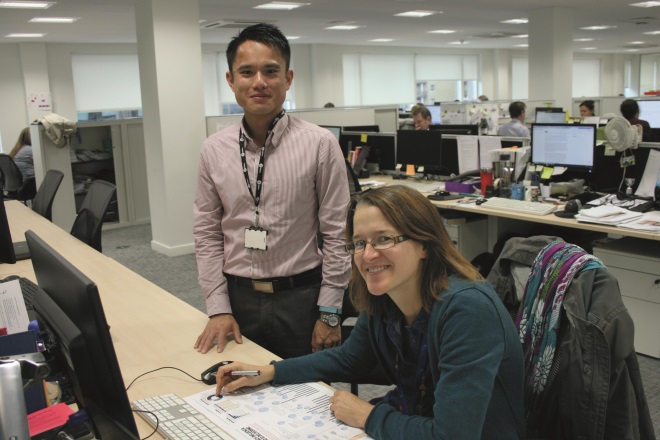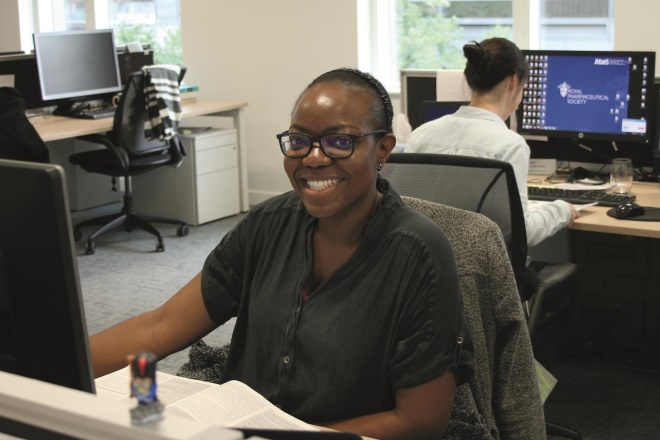
MAG / The Pharmaceutical Journal
The media is a highly competitive industry and perhaps one that most pharmacists would not have considered exploring as a career option. However, there are many pharmacists working in publishing. Having practised pharmacy they decided they wanted a change or a more varied career; some even have a career that they describe as “the best of both worlds” by continuing to do locum shifts.
The usual route in is through a pharmacy trade publication or a publication for prescribers focused on pharmaceuticals or medicines. Pharmacists applying to these types of publication find that their pharmacy degree and patient-facing experience give them an advantage over other applicants with degrees in life sciences.
A wide variety of postgraduate courses in science communication are available but, although these will provide you with experience that will give you confidence and may help you secure your first job, they are by no means essential. Employers provide training and most pharmacists working in publishing learnt on the job.
Postgraduate training
One pharmacist who took such a course is Kristoffer Stewart. He got his job as continued professional development (CPD) and clinical editor at C+D, where he works three days a week, after completing a one-year masters degree in science communication and public engagement at the University of Edinburgh.
“I was working as a pharmacist. I enjoyed it but I was also aware that, if I didn’t do something different now, I was going to stay in community pharmacy for the next decade onwards and stay in a similar role — moving up to pharmacy manager and then maybe an area manager,” he says, “I thought if I don’t try something different now I will probably never try anything new.”

Source: Courtesy of Kristoffer Stewart
Kristoffer Stewart is continued professional development (CPD) and clinical editor at C+D
Stewart considered hospital pharmacy but then he saw the science communication course. “I wouldn’t have applied for the job without the course — whether I would have been able to do it without the course is hard to tell,” he explains.
During his course Stewart had two placements: one at the Centre for Cognitive Ageing and Cognitive Epidemiology, where he produced videos and newsletters for a specialist audience and another at Moredun, an institute promoting animal health and welfare through research and education, where he gained his first experience in producing podcasts.
“The placements were probably the best part of the course,” he says. “Until you went out and practised the skills learnt you didn’t really understand what you had let yourself in for.” He added: “You were able to try different things — you could see what you like and what you don’t like and also what you are good and what you are not good at.”
Since joining C+D, he has made use of the podcast skills he learnt. “I have helped introduce them as part of the editorial team, so we now have those for CPD content and general news content,” he explains.
Stewart’s role is to commission, edit and sometimes write various forms of CPD content for print and online. He is also a sounding board for other members of the editorial team, most of whom do not have a pharmacy background. In the two days a week he is not working at the magazine, Stewart locums in community pharmacy, which he finds helps him develop CPD content.
“When I first started here I didn’t work in community pharmacy as much because I was trying to get my head around this new role. I didn’t think I would but I ended up missing community pharmacy — the relationships that you form in the community and putting your knowledge into practice.”
Creating content
Benedict Lam, senior editor of opinion and blogs at The Pharmaceutical Journal, also moved into publishing because he wanted a different career path to the linear route in community pharmacy. In 2008 he was interviewing for jobs in hospital pharmacy when he spotted an advertisement for a contributions editor. “I had no prior experience in either sector so it was going to be an exciting challenge and steep learning curve for me whichever role I chose,” he says.
He was sent on courses by The Pharmaceutical Journal and read books on grammar and editing in his spare time, “but the most important way I gained the skills to be a proficient editor is through my day-to-day work and feedback from my superiors and colleagues,” he says.
Lam’s role as a junior editor was to deal with unsolicited articles and letters. As he gained experience, he moved on to commissioning material and assisting the deputy editor with proofreading and final checks before the then weekly journal went to press. “My role then became more digitally focused and I was more involved with running the PJ website, and started running the social media accounts.”
Eight years on, now in the role of opinion editor, Lam enthuses: “I still get a buzz when I create content from a simple idea or a news story I come across. Everything moves fast in this world and you have to be on the ball because other publications will be racing to publish certain stories you want to do.”
He adds: “I would have never imagined when I graduated from university with my pharmacy degree that I would be working full-time in publishing. This is the beauty of a pharmacy degree. Don’t limit yourself to the obvious choices.”
Lam still works as a community pharmacist, has just started working as a bank pharmacist in a hospital as well, and writes and reviews registration assessment questions for the General Pharmaceutical Council. “I have no intention of stopping practising because I love problem solving for patients and helping them,” he says.

Source: MAG / The Pharmaceutical Journal
Benedict Lam and Dawn Connelly are commissioning editors at The Pharmaceutical Journal
Relationship building
The Pharmaceutical Journal has several other pharmacists or former pharmacists working for it, one of whom is features editor Dawn Connelly. Before joining the journal in 2001, Connelly was a hospital pharmacist and she saw an advertisement for a staff editor, similar to Lam’s first role.
From editing letters and articles sent in to the publication, Connelly moved to the news team, where she was responsible for gathering and writing news, attending conferences and writing features. She was then promoted to deputy news editor, assisting the news editor to commission and edit daily news stories, and is now the journal’s features editor. In her current role she works with both staff and freelancers to plan, commission and edit features and infographics.
“Editing other people’s work can be challenging because some people become attached to every word. It’s about managing relationships and being diplomatic while still making the feature the best it can be. Coming up with ideas can also be a challenge. There is pressure, but it is a different type of pressure to that I experienced when working with patients,” she says. “Sometimes I miss talking to and developing relationships with patients. But there are plenty of relationships to be developed in journalism too. In fact, success depends on good relationships, as it does in most jobs.”
She adds that a lot of the skills required to be a successful pharmacist are the same as those required to succeed in journalism, including “good oral and written communication skills, attention to detail, an analytical mind, good organisational skills and an ability to work to tight deadlines.”
Producing accurate information
There are also roles for pharmacists in more specialist and evidence-based publications, such as journals and directories.
Kere Odumah worked in community pharmacy for four years before joining the
British National Formulary
(BNF)— which is published by Pharmaceutical Press, Royal Pharmaceutical Society — in 2014 as a clinical writer. The writers rotate every three months through four areas — monographs, projects, quality and assurance and treatment summaries.

Source: MAG / The Pharmaceutical Journal
Kere Odumah is a clinical writer for the British National Formulary
Odumah is currently working on monographs, which involves updating content to take into account new drugs, and liaising with organisations which produce guidelines to ensure that the BNF’s information is in step. On other rotations she will write treatment summaries, and work on the publication’s standard operating procedures and help develop and implement new ideas. The project team is constantly looking for ways to improve the BNF’s content, such as by including more clinical advice rather than just reproducing summaries of product characteristics (SPCs), and to manipulate data to make it more user friendly.
When Odumah joined the BNF she found she was learning a lot but missed putting it into practice and the patient contact. “We worked out a way for me to do that,” she says. Now she works 15 hours per month as a pharmacist, which she finds helps with her writing.
Supporting evidence-based medicine
David Phizackerley, deputy editor of Drug and Therapeutics Bulletin (DTB), moved into publishing because of his passion for evidence-based medicine. Phizackerley had worked in the NHS for 23 years, first in hospital pharmacy then as a pharmaceutical adviser at a Family Health Services Authority, where he analysed prescribing data and advised GPs on their prescribing. That role changed as NHS commissioning structures changed, but the vital element of improving patient care through the promotion of cost-effective, evidence-based prescribing remained.
Around seven years ago, he saw an advertisement for the deputy editor role at DTB and it was a perfect fit. “DTB has a reputation as one of the key publications able to influence and promote evidence-based prescribing and I felt that it would be an interesting place to work,” he says. “It was in line with my interest of improving patient care through providing high quality information to prescribers.”
Phizackerley oversees the whole cycle of publishing the monthly journal from start to finish. This begins with developing ideas in conjunction with DTB’s editorial board, checking that there is enough evidence to make an interesting article that adds something new, commissioning and overseeing the peer review process, and sometimes doing live radio and television interviews when articles are picked up by the national media.
Usually when an article is peer reviewed it is sent out to two or three sets of experts for comment and may be amended in light of those comments, but the DTB does things differently — a first draft is commissioned and then sent out to 30–40 experts.
“We may get 10–15 sets of comments back,” Phizackerley says. “We can get 15 different views on something. That can be quite challenging when you get diametrically opposite views.” His job is then to make sense of those comments to produce an article that appears without a named author and is the view of the publication.
Phizackerley explains: “Pharmacists have a reputation for attention to detail and for being aware of issues relating to patient safety.” He adds that these are helpful attributes when preparing accurate, high quality articles that may have an influence on patient care.
Considering the future
While publishing offers a diverse, creative and rewarding career, it can also be stressful. The need to maintain a continuous pipeline of content at all stages and to respond to situations outside your control, such as changes in policy or clinical advice — often at the last minute — means there are very few quiet periods. And, unlike in some pharmacy sectors, there is often no clear career path.
While none of these pharmacists see themselves returning to practising pharmacy full time, none of them know where they will end up. But they see the fact that publishing offers a multitude of career directions as a positive thing. Changing their role within their publication or moving to another publication are the obvious options, but there are other possibilities, such as working for agencies or organisations that produce healthcare communications. Even if they do choose to stay in the same role, their jobs are unlikely to stagnate because publications constantly review their format, content and use of digital and social media.
A career in publishing is not mundane, emphasises Odumah. “There is always something new… you don’t have time to get bored.”
Reading this article counts towards your CPD
You can use the following forms to record your learning and action points from this article from Pharmaceutical Journal Publications.
Your CPD module results are stored against your account here at The Pharmaceutical Journal. You must be registered and logged into the site to do this. To review your module results, go to the ‘My Account’ tab and then ‘My CPD’.
Any training, learning or development activities that you undertake for CPD can also be recorded as evidence as part of your RPS Faculty practice-based portfolio when preparing for Faculty membership. To start your RPS Faculty journey today, access the portfolio and tools at www.rpharms.com/Faculty
If your learning was planned in advance, please click:
If your learning was spontaneous, please click:


